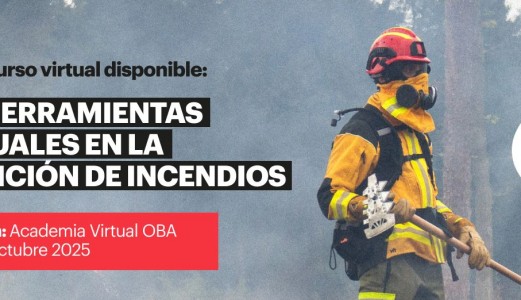The year 2021 was a year of contrasts. Chile reported its worst season of forest fires, Patagonia witnessed a change in its normal fire regime, characterized by simultaneous significant events and the entire Mediterranean Arc underwent its first extreme and cross-sectional episode. Siberia continued exhibiting the abnormal weather conditions of recent years and territories with a history of large scale climate disturbances, such as California, Australia and Canada broke records once again with figures and events that had never been seen before.
Chile
On December 31, 2020 the Chilean government launched a warning that the country could live through its worst season of wildfires. After a 10-year drought, the central-southern region of the country was undergoing an unprecedented water crisis. The high temperatures and strong winds typical of the Chilean summer were foreboding a complicated situation for the emergency services.
The first large disturbance was not long in coming. A fire started in Valparaíso, in an area that was difficult to access because of its topography, stained the sky red over the city of Quilpué, damaged hundreds of homes and had CONAF personnel on edge for weeks.
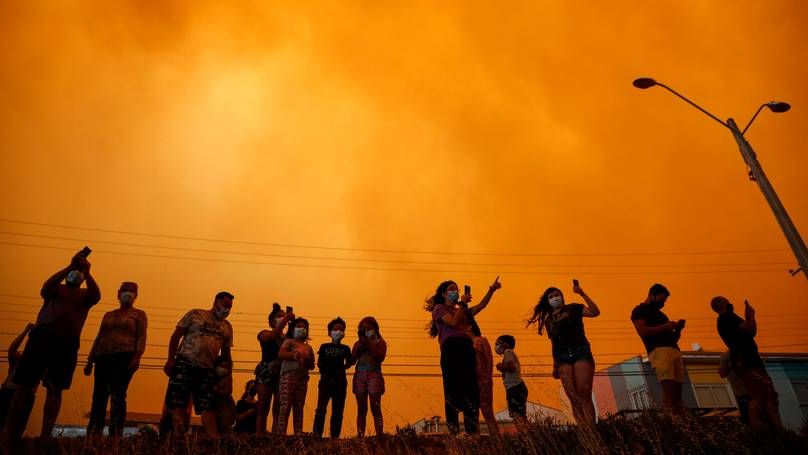
Source: BBC.
The flames destroyed 4,200 hectares in a single weekend while the firefighters tried to stop the fire from advancing to the Lago Peñuelas National Reserve. The firefighting teams were finally able to join their control lines on January 20. The truce lasted seven days. At 11 a.m. on January 27, the Forest Fire Chile prevention service reported a new fire in the Los Peces River.
At the start of February, a fire in Fundo Monterrey threatened to engulf the dividing line between the town and the forest; another fire started in the Chilapa sanctuary in Checa, where 10-kilometer-long fire lines were reported. In the middle of April, a new fire in the Valparaíso region affected a preliminary area of 51.1 hectares of natural vegetation and pine plantations.
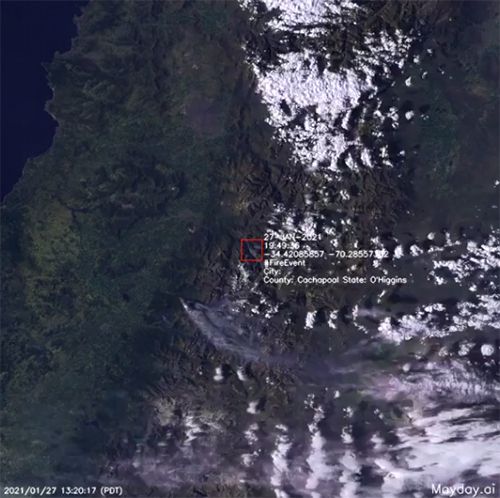
Source: Forest Fire Chile.
Chile ended the year by decreeing an agricultural state of emergency due to the increase in forest fires. In 2021, the country registered a 380% increase in burned hectares over the previous year.
The Patagonia in Argentina
The end of January witnessed a heat wave and lack of precipitation that lasted a month and a half. Although summer is the dry season in this region, the conditions were heightened this year. There were no marked drops in temperatures at night. This had a significant impact on the water content of potential fuels, not only fine fuels (grasses, pine needles and so on), but also medium and coarse fuels (boding fast and intense fire runs if ignition occurred). At the end of January, a fire in El Bolsón destroyed 6,500 hectares in a little over 24 hours. This complex scenario made it necessary to mobilize hundreds of firefighters and divide the operation into six sectors. In the words of the members of the Splif Río Negro firefighters: “We had never seen anything like this”.
The abnormal temperatures continued in February in Patagonia and the Southern Cone, with maximum temperatures 10ºC over the average for that time of the year. The temperature at Puerto Williams (at the southernmost point of South America) surpassed 26ºC, a record set in 1984.
On March 1, the technical area of the Fire Management Service warned of potential danger due to the entry of a cold front from the Pacific. This sum of factors in an area with mature vegetation and interface areas on the slope of a hill, high density of buildings and surrounding vegetation, not always properly managed, was the favorable setting for extreme events.
On March 7, two large fires occurred in Comarca Andina on Parallel 42 of Patagonia, both of extraordinary characteristics and severe social and environmental consequences.
There were two fifth- and sixth-generation wildfires. They were simultaneous and of high intensity. Two fires with similar shapes and over similar areas, but very different from each other. In terms of the affected area, we're talking about wildfires covering nearly 15,000 ha, with the difference that one burned for three months and the other for 9 hours, with environmental and socioeconomic impacts never seen before in that location. The first started in the Costa del Tornero complex and in Boquete, in El Bolsón, in the Río Negro province. The other started in Chubut, the province to the south of Río Negro, in Las Golondrinas.
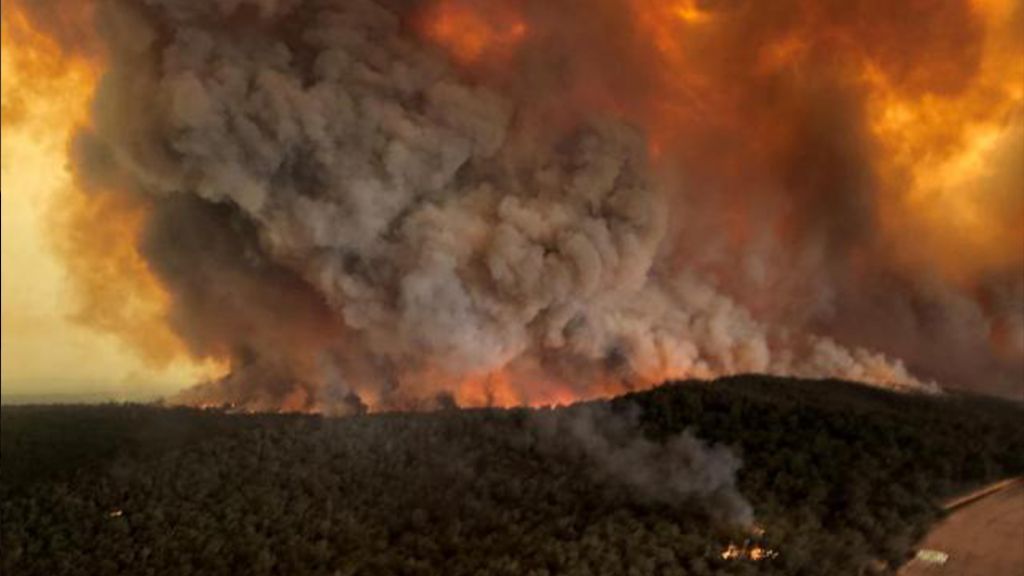
Source: Agrolatam.
The fire in Costa del Tornero started at the end of January. The extreme intensity of the flames and fast fire runs over the forest cover and pastures took us by surprise. On the worst day, the fire front advanced 9.13 km in half a day. To put this event into perspective, we could say that the length of the wildfire on that day grew to the size of 76 football fields. This same fire was reactivated at the beginning of March and spread once again virulently.
In the afternoon of March 9th, two fires started in the same district of Río Negro and turned into a single fire in a matter of hours: the Las Golondrinas-Radal fire. This second event behaved much more explosively. Not only wooded areas were burnt, but interface areas as well, with the loss of over 500 homes and the deaths of 3 civilians. A speed of 10.4 km/h was logged at the peak of the fire.
Australia
On the other side of the Pacific, the month of January witnessed two fires that activated the Emergency Alert in Western Australia. One to the east and another to the north of Perth, the capital.
200+ firefighters are still working tirelessly in extreme terrain & conditions at the Wooroloo #bushfire. Erratic fire behaviour fanned by strong winds continues to challenge crews on the frontline who are protecting what they can & putting containment lines in place. #perthfires pic.twitter.com/7NUTLz0IWU
— DFES (@dfes_wa) February 2, 2021
Hundreds of firefighters from the DFES (Department of Fire and Emergency Services) worked tirelessly under extreme weather conditions in Wooroloo. The fire was erratic and stoked by strong winds and razed dozens of homes, defying firefighters and their equipment. The former attempted to save what they could by deploying containment lines and carrying out self-defense maneuvers.
South Africa
In 2021, South Africa, one of the countries with the most wildfires in the world, underwent one of its most tragic episodes. An out-of-control fire in Cape Town Table Mountain entered an urban interface, where it destroyed homes, causing injuries and the evacuation of the population, as well as the destruction of the Jagger Library of the University of Cape Town, an emblematic building that housed hundreds of thousands of antique books and manuscripts.
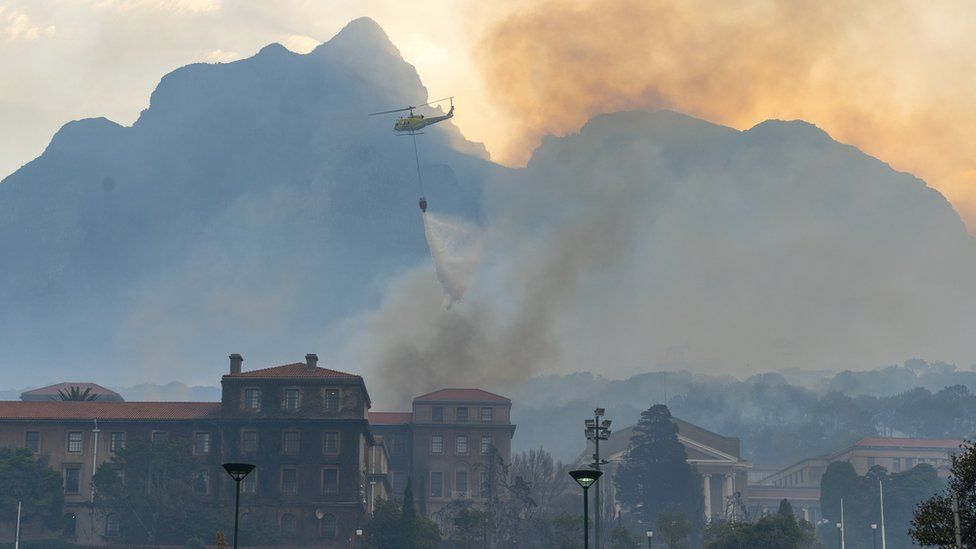
Source: Reuters.
The Mediterranean Arc
During the summer of 2021, the situation in the southeastern Mediterranean was exceptional. Unpredictable winds, record temperatures, LFF (Large Forest Fires), simultaneous fires, wildland-urban interfaces and large surface areas. Three waves of sub-Saharan heat that settled from eastern to western Europe caused the first extreme incident that affected the Mediterranean Arc from end to end.
Let’s take a closer look at the specific cases.
In Turkey, a total of 112 wildfires were reported, some of which were very powerful. The resulting count was 547,000 ha burnt, 8 deaths and 864 people injured. The worst campaign in the last decade. The worst befell the tourist areas of the Aegean Sea in the southwest of the country, where 10,000 people were evacuated. During the same period, the Drought Code map showed the Antalya Province as the most severely affected in Europe.
In Greece, forest fires threatened the ruins of Mount Olympus. In the suburbs of Varimbombi and Adames, near Athens, nearly five hundred firefighters were mobilized.
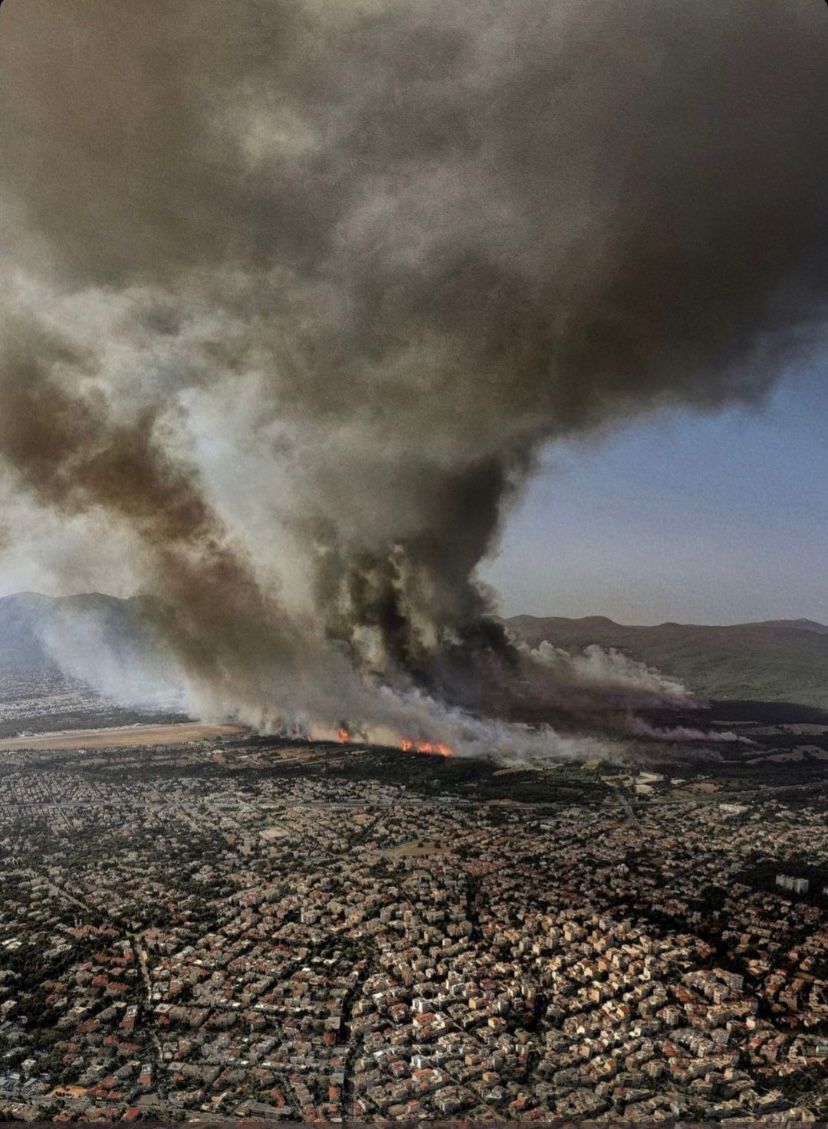
The fire to the north of Evia had a 25-km front and destroyed more than 80,000 ha.
This is what the future looks like, arriving.pic.twitter.com/kGLnGxb35S
— James B (@piercepenniless) August 7, 2021
In July, Copernicus launched an alert for what ended up being the worst wildfire in Cyprus’s history.
Italy was plagued by more than 160 fires. The regions affected the most were Sicily (8,669 interventions), Apulia (8,628) and Calabria (3,785) all in the south. A completely unexpected fire in Pescara on August 1 threatened the Natural Reserve of Pineta Dannunziana. The drought, combined with the heat from the Sahara (the highest temperature increase since 1987, close to 50ºC) caused large simultaneous fires. Most of these were driven by winds. Many crossed over urban interface areas.
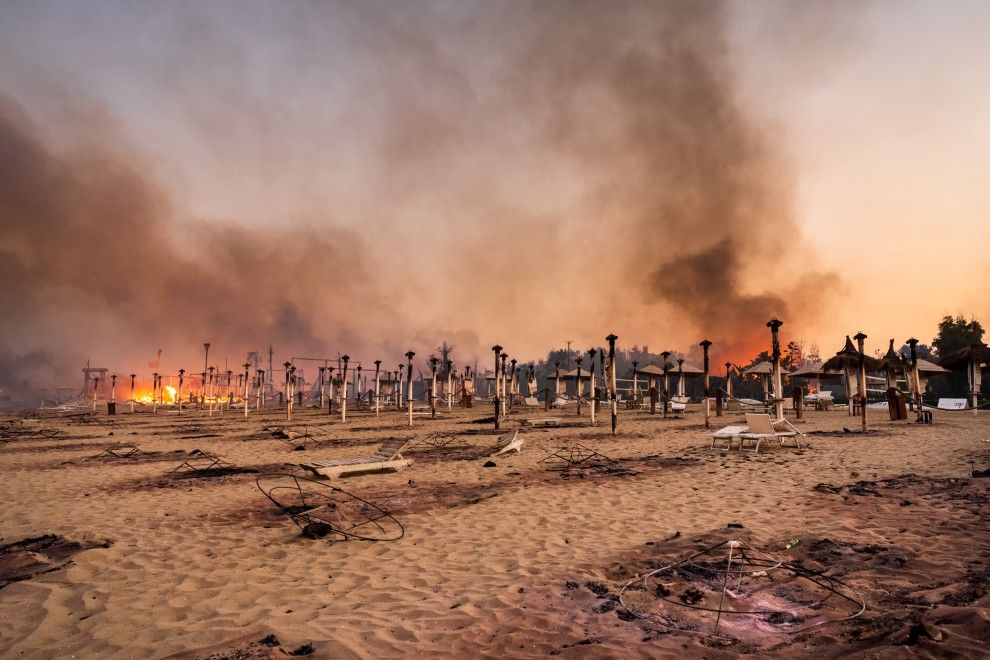
The country suffered the worst heat wave in the previous 40 years, with temperatures reaching as high as 47.1ºC in the north of the country. The winds reached 6 points in the Beaufort scale. Given the complexity of the scenario, consisting of flames that defied direct action and columns of convective smoke that impeded aircraft visibility, firefighters made the most of night-time windows.
One of the deadliest wildfires in 2021 was in Algeria, where nearly a hundred people lost their lives. A fire in the south, overheated by a foehn effect and massive secondary blazes, set several ravines alight and trapped the town of Tizi Ouzou, located at the top of the ridge. 29,000 hectares were destroyed in 3 days.
On August 16, a fire in the commune of Gonfaron (VAR) in France razed 2,200 ha in a single night. The fire threatened to enter the urban interface at Garde-Freinet, Grimaud and la Môle and caused the evacuation of numerous camp sites. There were also two serious fires in August in Marseille (2,000 ha) and the Cote Azure, (7,000 ha).
In the early morning of August 16, a fire was declared in the town of Castro Marin, east of Algarve, Portugal, near the border with the Spanish province of Huelva. The fire grew in strength until it covered a perimeter of 43 kilometers and advanced at a rate of 650 hectares per hour, with sufficient potential to destroy up to 20,000 hectares. The firefighting elements put into action, which consisted of more than five hundred firefighters, land vehicles and aircraft, were able to stabilize the fire in three days. The fire burnt nearly 6,700 ha and 80% of the National Forest of the Tavira Municipality.
Spain
The year 2021 was a specially difficult year for Spanish emergency services. An Arctic cold wave swept through the Iberian Peninsula in January. This blizzard, baptized Filomena, caused three deaths, stranded thousands of people, was responsible for countless material losses and left numerous cities with no communication by land. It was the most severe winter storm in 50 years and left both hospitals and nursing homes isolated in the midst of a pandemic. In the Community of Madrid alone, the government ordered over 5,000 sorties by the emergency services, which included clearing roads.
Los brigadistas de las bases de @briflubia #Soria y @brifpuertopico #Ávila colaboran desde esta mañana en tareas de retirada de hielo y nieve en puntos sensibles de las dos provincias. El resto de #BRIF de #CastillayLeón podrían ser requeridas también para este tipo de trabajos. pic.twitter.com/qI66TVMTkO
— Delegación del Gobierno en #CastillayLeón (@DGCyL) January 12, 2021
The OSBO Digital publication warned of the potential secondary effects of the snow storm in an article titled “Filomena can turn the forests into tinderboxes”.
The first fires came earlier than usual (January 23 in Berja, Andalusia, January 31 in Granada and February 1 in Olula de Castro, Almería). In February, 31 active fires were declared in Cantabria, one of which was especially fierce and affected Uceida.
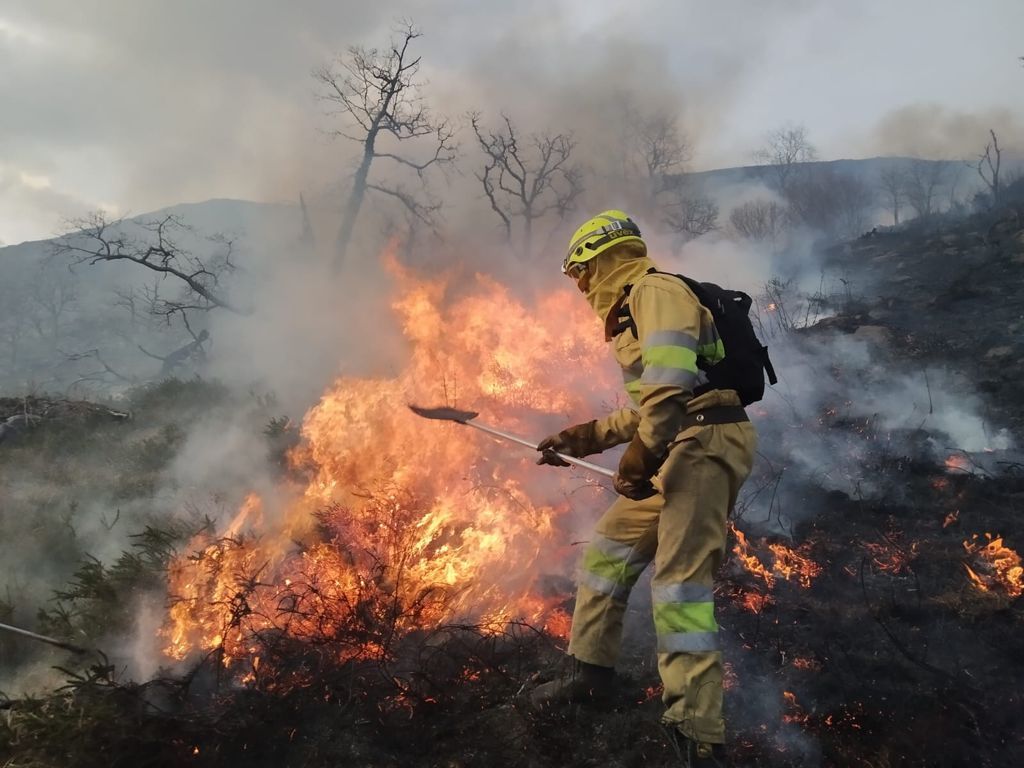
Source: Government of Cantabria.
The first large firefighting operation was deployed in the spring, in Arico, Tenerife. The fire reached a maximum perimeter of 25 km and entered the Teide National Park, which required action to be taken by a large number of firefighting brigades, as well as the Military Emergencies Unit.
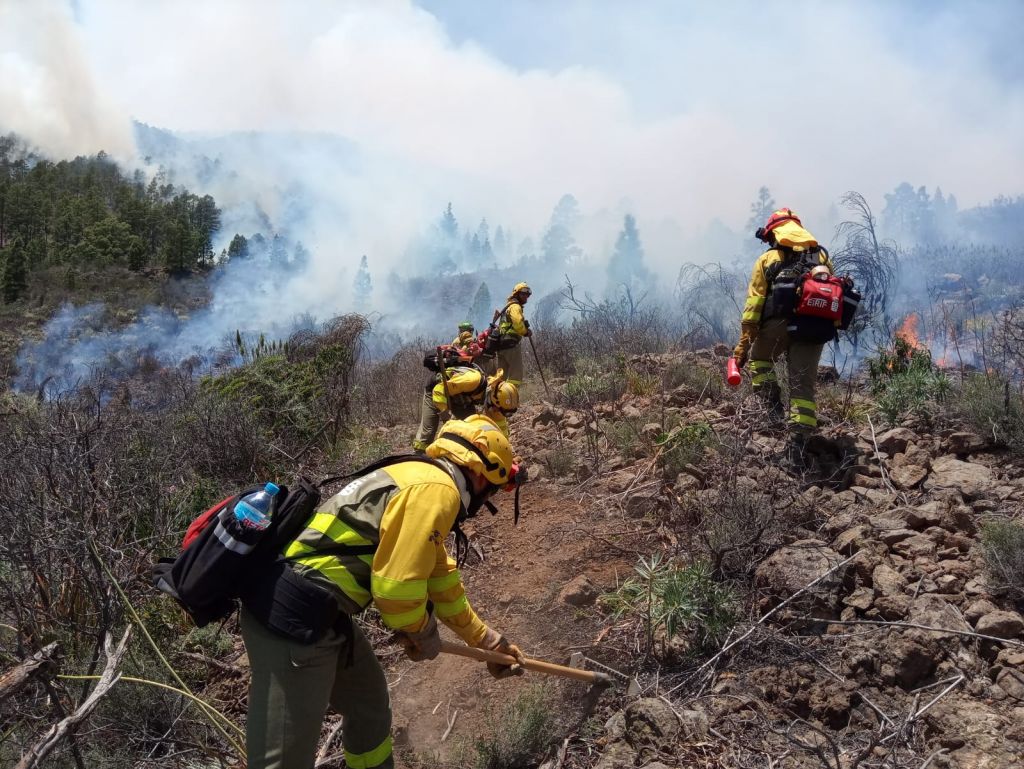
Source: EIRIF, Gesplansa.
The first large firefighting operation was deployed in the spring, in Arico, Tenerife. The fire reached a maximum perimeter of 25 km and entered the Teide National Park, which required action to be taken by a large number of firefighting brigades, as well as the Military Emergencies Unit.
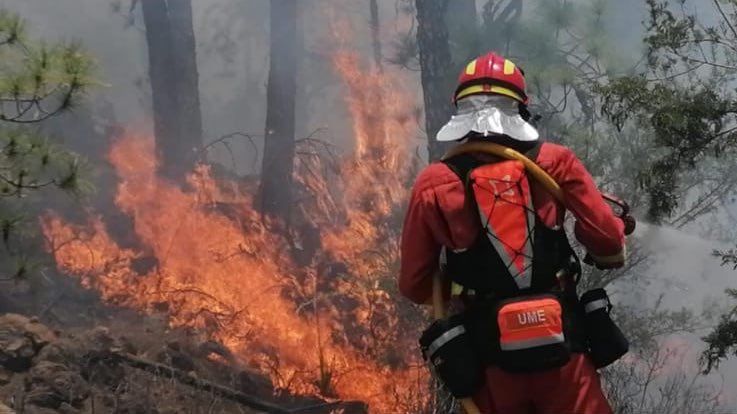
Source: UME (Military Emergencies Unit).
Three very large fires took place in the summer. In the middle of July, a fire storm in Santa Coloma de Queralt, became convective and passed through the Miralles sierra. On day 2, the weather became favorable for the generation of large convective clouds (pyrocumulonimbus) and the fire spread through the entire slope, forcing the confinement of the residents in Sant Martí de Tous and Santa María de Miralles. The fire razed over 1,600 ha in a single weekend.
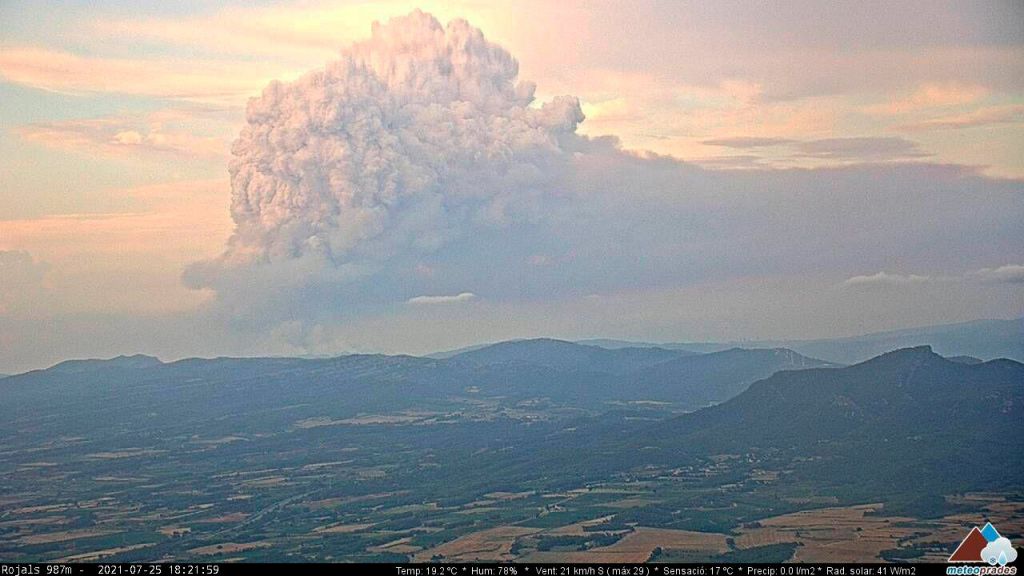
Source: MeteoPrades.
The firefighting units had foreseen this behavior and made sure that all the units involved put in place containment barriers and used technical fire measures. These tactics enabled them to confine the fire, which was declared under control on July 26.
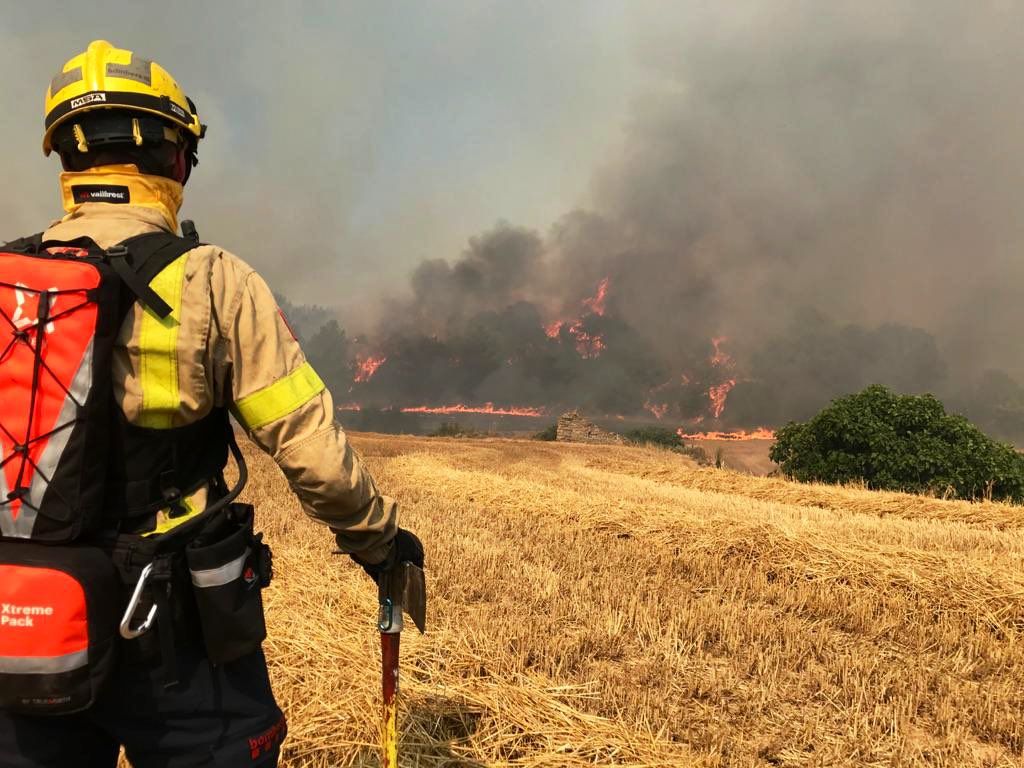
Source: EPAF Montblanc.
The fire in Navalacruz, Avila in August destroyed 21,993 ha and became one of the largest in Spain’s history. The size of the fire and the major deployment of firefighting personnel and equipment revealed two new factors. First, identifying flanks, head and back, whether in the north or south is useless in the case of large fires where it is not clear which way the fire is spreading because of different wind directions (like when a large fire is conquered by a slope). On the contrary, identifying the cardinal points and the center of the fire as the points of reference and dividing areas into sectors is much more useful because these are invariable. Likewise, since the intensity of the fire did not allow land-based personnel to attack the fire directly, a lesson was learned about how to manage and coordinate large numbers of firefighting means and a highly complex operation.
In September, a fire in Jubrique, Málaga required the presence of more than fifty professional firefighters. The dominating winds in the area made it very difficult to put out the fire. A convective fire, the embers of which ignited a new fire in Sierra Bermeja and caused the death of a firefighter assigned to the Infoca Plan. The flames razed 148 ha of Spanish fir (protected species).
Although the Lucena del Puerto fire in Huelva was less fierce, it also posed a challenge for the firefighting brigades, given the difficult working conditions: southwesterly winds at 15-20 km/h, with gusts of up to 30-35 km/h, abundant fuel and steep slopes.
In mid-September, a new event put the Spanish emergency services to the test. The eruption of the Cumbre Vieja volcano on the island of La Palma covered over 1,200 hectares, burying hundreds of farming plots, thousands of homes and 92 kilometers of roads in 86 days of activity. According to conservative calculations, 159 million cubic meters of lava were expelled and earthquakes were registered throughout the entire Canary Islands during three months (approximately 300 earthquakes were registered in 24 hours on the days with the most intense seismic activity).
Siberia and the Russian Far East
For the third straight year, western Siberia registered abnormally high temperatures this spring.
A massive fire on April 16, fueled by 20 mps winds (72 km/h), which threatened the Khakasskuy Natural Reserve, required the mobilization of dozens of firefighters and volunteers.
In May, several fires in the city of Kamyshlov blocked the R351 road from Ekaterimburgo, in the Ural Mountains, to Tyumen, in western Siberia. They also made it necessary to close the Kolyma, which is the main road connecting the capital of the Republic, Yakutsk, and the port city of Magadan on the Sea of Ojotsk. The regions of Sverlovsk and Tyumen were struggling against forest fires from the end of April.
In mid-July, Russia mobilized the army to extinguish a forest fire that had burned 1.4 million hectares in Yakutia, the coldest and largest region in the country. In August, the combination of fog and smoke from the fire blocked the sun over the apocalyptic landscape of Yakutia.
The cameras on Copernicus detected large concentrations of smoke around the North Pole for the first time ever, covering an area of 5.3 million square kilometers and predicted that the smoke would cross over the Arctic Circle and reach Greenland.
The scientific community warned that the forest fires in Yakutia would again ignite large peat and young coal deposits. “If the white ice reflects the smoke, the albedo, and is covered with ash, the darker color of the ice could generate a change in temperature”. This was taken from the statements by the head of research of the Pau Costa Foundation. Last winter, one of these peat deposits ignited by a summer forest fire continued to burn under the surface for an entire year, withstanding a rainy autumn and an extremely cold winter. This phenomenon is commonly known as a “Zombie fire”.
Current wildfires in Yakutia, Russia’s coldest region will reignite/set on fire large deposits of peat & young charcoal. As we saw it last winter, one of such peat deposits ignited by last summer’s wildfire didn’t stop burning after a long rainy autumn & the extremely cold winter pic.twitter.com/isdZ07rbKr
— The Siberian Times (@siberian_times) July 21, 2021
By August 11, a total of 6.6 million hectares were burned in Yakutia. The contamination from the forest fires reached the Urals and the Yamal peninsula in Russia, Kazakhstan, the North Pole, Mongolia and Canada.
Canada
On June 30, temperatures of 49.6ºC were recorded in Lytton, southwest of British Columbia, during a historic heat wave that ignited several wildfires and led to a fire storm in which 710,117 lightning bolts were recorded in 15 hours.
Canada has broken its all-time heat record for the 3rd day in a row, with Lytton B.C. hitting 121°F.
— Alec Luhn (@ASLuhn) June 30, 2021
233 deaths were reported in B.C. in 4 days, 100 more than average. "It is expected that extreme heat has been contributory."https://t.co/8JQrqzpHg3 pic.twitter.com/mr8vKBU3GS
According to information from meteorologist Chris Vagasky, 597,314 lightning bolts were cloud-to-cloud and did not touch the ground, whereas there were 112,803 cloud-to-ground bolts in the same area (lightning associated with pyro-convective clouds). This extreme episode triggered more than 130 new forest fires, destroyed Lytton and caused nearly 500 deaths.
MONSTER pyrocumulonimbus in British Columbia this evening!
— Kyle Brittain (@KyleTWN) June 30, 2021
Here's a snippet. #BCfire @weathernetwork pic.twitter.com/lyUN2rPBZN
The 2020 wildfire season in British Columbia was “calm” (637 forest fires that burned a little over 15,000 hectares). The average between 2010 and 2020 was 1,356 fires/year. That is the equivalent of 347,104 hectares per wildfire season.
California
California has seen recurrent episodes of simultaneous and fierce fires; however, this was one of the worst seasons on record.
A fire, later known as the Dixie Fire, was declared on the morning of July 13 after an electrical distribution line was hit by a falling tree near the Feather River Canyon. Ten days after it started, it had become the largest forest fire of the season.
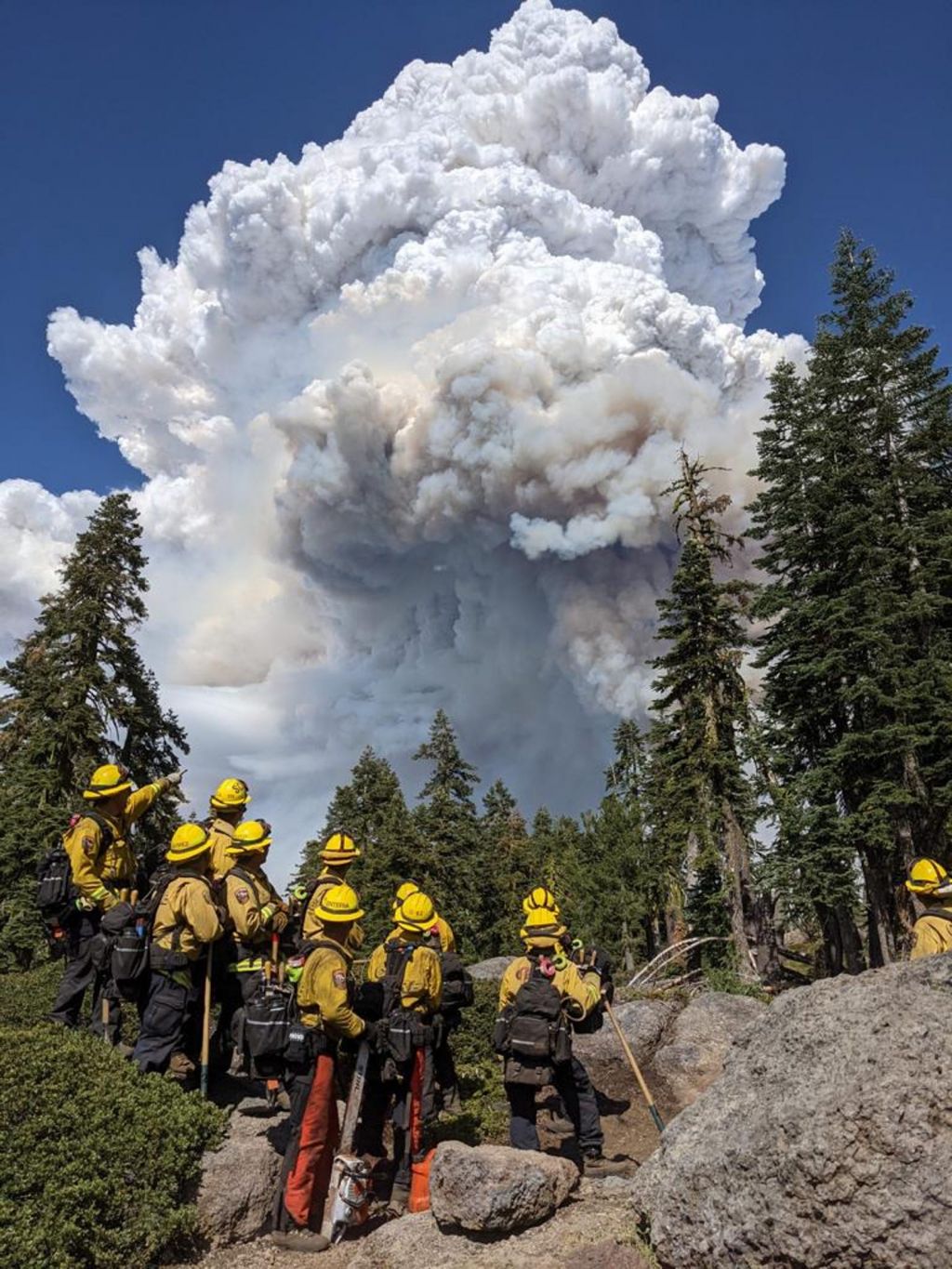
Source: Calfire.
On August 6, after burning an area larger than the State of Rhode Island, it was classified as the single largest fire in the history of California and the second largest in general (after the August Complex Fire in 2020).
The six largest wildfires in California history.
— Dakota Smith (@weatherdak) August 6, 2021
Five of which have occurred in the last year.
All in the last three years. pic.twitter.com/APrSyXBKxk
The smoke from the Dixie Fire compromised the air quality of the entire western part of the United States, including Utah and Colorado.
These are some of the figures collected on August 6, 24 days after it started:
- Start date: July 14 2021 12:00 AM
- Surface area burned: 175,962.578 hectares (434,813 acres)
- Perimeter contained: 21%
- Personnel involved: 5,118 people
- Buildings threatened: 13,871
- Buildings destroyed: 184.
The Dixie Fire burned a total of 963,309 acres (389,837 hectares) before it was completely extinguished on October 25, 2021. This leads us to reflect on long-term emergency management.
Notable among the hundreds of fires that scourged the West Coast of the United States were the Caldor and Chaparral Fires, which also exhibited extreme characteristics (firenadoes, pyrocumulonimbus clouds, cyclonic and anti-cyclonic rotations on different flanks, etc.).
Firenado (more correctly called a fire whirl) at the #ChaparralFire You only realize the scale when you see the helo and firefighter. @CALFIRERRU pic.twitter.com/OOlFV7h9R0
— FirePhoto101 (@FirePhoto101) August 29, 2021
The six worst fires in the history of California have taken place over the last 3 years. The scientific community sees the clear influence of climate change on the extreme heat waves that have contributed to increasing the strength of fires this summer. More than 35,000 people had to be evacuated.
What awaits us in 2022?
In the last month of the year, we again saw numerous fires in Argentina, in the Córdoba region and Patagonia. The forecast for the Andean country in 2022 is not very favorable. A worrisome (and historic) heat wave is affecting South America, as shown by the satellite images of the NASA. Peak temperatures of 54ºC were seen on January 11 in Argentina. Anomalies in air temperature of more than 10ºC are expected in the days to come.
Chile and Argentina are undergoing a historic drought once again.
Este enero tuvo uno de los eventos cálidos más importantes de los últimos años. Se registraron más de 75 #récords de temperatura y se superaron los 40°C en 21 provincias.
— SMN Argentina (@SMN_Argentina) February 2, 2022
Los mapas muestran las temperaturas máximas absolutas en periodos de 10 días.
✅ https://t.co/GAB4DlIxjh pic.twitter.com/HDeK74vOHl
There will be large fires in the Río Negro region again. The firefighting campaign is South America promises to be complicated.
In 2021, the wildfire season was longer than usual in most of the world, primarily due to higher temperatures. We saw an increase in large fires, which are fiercer and have more severe consequences. The experts are starting to talk about “Fire weather” (when high temperatures, low humidity, lack of precipitation and/or strong winds generate a high risk of forest fires).
The Fabra Observatory in Catalonia published data that showed that 2021 was the driest on record (327.6 mm, half of the climate median) and the fourth warmest (+1.7ºC over the climate median).
A report by the IPCC (Intergovernmental Panel on Climate Change) states that “with a global temperature increase of 1.5º, the heat waves that previously took place every ten years will occur every 4 years and will be 2ºC warmer. However, there is hope that the temperature will not rise more than 1.5ºC if we stop emissions and capture carbon”.





